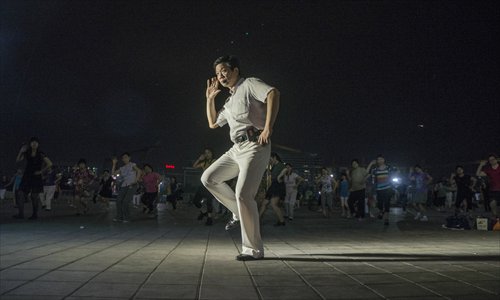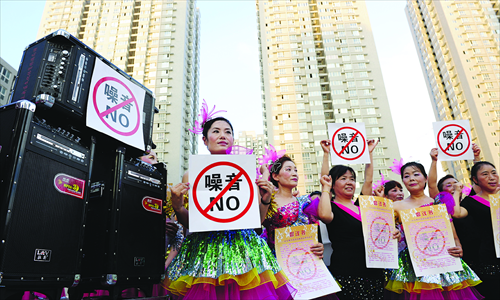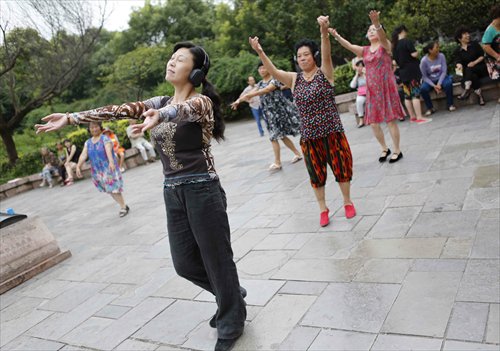Dancing and jogging, China’s burgeoning elderly population swarm onto public spaces

A middle-aged man leads about 200 elderly women in an enthusiastic dance at a square in Wukesong, in Haidian district of Beijing. The dancers show up every day, rain or shine. Photo: Li Hao/GT
Whenever Zhang Tianyu walks past the square next to his apartment compound at night, he can always hear thumping music. Zhang, a senior college student, lives in what is considered a fairly small town in China, with just 120,000 people. It is neither a nightclub nor a rowdy bar that is making the noise.
It is the hundreds of middle aged women who congregate at the square each day to dance in strict formations.
The issue bothered him so much he stopped eating at restaurants around the square and instead gets food to take away. He feels angry whenever he hears the sound of pop music coming from the low-quality speakers in the square.
Zhang is not alone. There have been conflicts caused by such dance groups around the country. Many have battled the dancers using a variety of methods, some civilized and some much less so. In one case, enraged locals dumped excrement on them from a nearby building, in another case, a separate set of loudspeakers were set up to blast other music at the baffled dancers.
The Chinese dama (middle-aged and elderly women) have in recent years become famous for these dances in public squares, known as guangchangwu, and also for other forms of exercise such as power walking. But most of the time they aren't presented in a good light.
Despite a flurry of media reports about the dancers and how they are occupying space in cities with loud music, few have considered the health aspects of this trend, instead opting to focus on the clashes with local residents. But as the nation's population ages, these kinds of conflicts are only going to increase as elderly residents continue to look for public forms of exercise.

Guangchangwu dancers in Xi'an, Shaanxi Province, vow to reduce noise while dancing. Photo: CFP
Phenomenon on the rise
Ding Shouzhen and Jia Xixiang, a retired couple, have been leading dances at Tuanjiehu Park in Chaoyang district for about three years. Every night at precisely 7:30 pm they arrive at the park with a tall stereo and start playing the music.
Fifty-three-year-old Ding and Jia are dance leads for about 200 people. Back then they had just started learning the dance steps. But the lead dancer became sick and Ding and Jia took the lead.
There's more responsibility and effort in this dancing than people might think, Ding told the Global Times. She said that in order to lead dances, she has to constantly look up videos online to learn new moves.
For the last few days, the square dancing team has been dancing to the catchy tune of "Little Apple," a song by the Chopsticks Brothers that went viral on the Internet last month among young people. Passersby stop and take photos of them, some exclaiming, "These dama are so fashionable!"
There are more and more dancing elderly women because the need for exercise is on the rise, Qiu Jianxin, a sociology professor at the Nanjing University of Aeronautics and Astronautics, told the Global Times.
"Now that elderly people have satisfied their material needs, they are demanding to satisfy their emotional needs as well," he said. "Guangchangwu gives them a sense of belonging and provides opportunities to socialize."
Ding said that even though she doesn't know the name of everybody dancing in the team, she does recognize some faces, who have been dancing with her all these years. Besides, exercising in the open has brought unexpected health benefits.
She said that she and her husband used to have trouble falling asleep every night and needed to take pills. But ever since they started dancing every night, their health has improved and they have been able to sleep more easily.
Compared with other means of exercise, dancing is not only cheap but easy to follow, Ding said.

Women dance wearing headphones to reduce noise in a square in Guiyang, Guizhou Province, amid rising conflicts between dancers and the rest of the public. Photo: CFP
Resistance grows
Guangchangwu activities have met with strong resistance.
Zhang said that whenever he is near the square, he is unable to do many things. The noise means he can't take phone calls, he can't watch videos, and every sound is drowned out by the music.
"I think public spaces have certain rules. If a group of people make loud noises there, that's breaking the rules," he said.
Many people feel the same way about guangchangwu, and these voices are often heard in media reports.
In April 2013, residents threw water bombs at dancers in Chengdu, Sichuan Province. Local community workers came to mediate between the residents and dancers but failed. The conflict persisted.
Water bombs are far from the worst things that have been flung at dancers. In Wuhan, Hubei Province, a group of elderly women were sprayed with urine and excrement for dancing near the residential buildings and making noise at night, the Wuhan Evening News reported.
When conflicts break out, there isn't a mechanism for solving them and these primitive methods of protests have continued.
In Xi'an, Shaanxi Province, a draft was issued on noise pollution. It stated that people who entertain, exercise or celebrate on streets, squares and parks next to residential compounds should use measures to reduce the noise. If the noise gets too loud, they can be fined 200 yuan each.
But the plan still hasn't provided a solution for where these women can go if they are banned from dancing at certain places.
Meeting resistance, some dancers have switched to other exercise methods, but are still being criticized.
A group of dama instead became power-walking "mobs." In Xuzhou, Jiangsu Province, many people complained that at precisely 7:30 pm every day, the local dama, up to 1,000 in number, would line up in threes and power walk. Sometimes they even block traffic, the Nanjing-based Modern Express reported.
Some have switched to more creative ways. Media reported that a group of dama in Chongqing Municipality started wearing wireless headsets and danced without the music.
Ding said her group was careful to choose a time suitable for other residents in the area. She said the group starts at around dinner time and finishes when the park closes at 10, a time that most people are still awake. Besides, the music is turned down to an audible level only and shouldn't disturb anyone, she said.
City planning failure
There is nothing else they can do if they receive complaints, Ding said.
"We don't have any other venues," she said. "Chaoyang Park is too far. Around here, we only have Tuanjiehu Park, and all other places are residential compounds."
Statistics from the Ministry of Civil Affairs show that in 2013, there were more than 200 million senior citizens in China, which represents 15 percent of the entire population. In cities such as Shanghai or Beijing, the proportion might be well over 20 percent.
Out of the people over 60 in China, only 3 percent are able to attend education facilities for the elderly, and 562 people on average share one activity room. There are few facilities built for elderly citizens.
"There's nothing wrong with the dama wanting to exercise, they just have to keep it down so that they don't bother any residents, which I think most people are capable of doing," Hu Xingdou, a political science professor with the Beijing Institute of Technology, told the Global Times.
"However, the key issue is that cities and communities in China should leave enough space, especially green space, for these people. In China, the average number of public exercise facilities is only one-10th of what Japan has," he said.
Right now, there is not enough space to satisfy all the demand. The Guangdong-based Qingyuan Daily reported in 2013 that two groups of dancers in the city fought for a square to dance in. Over 200 people danced in an area that was only 50 square meters.
After the fight, one of the teams shifted to another square nearby, but three teams of dancers were already fighting over that area. The manager of the park told media that in that district, there are only 13 squares, but there are over 40 teams, each with at least 100 people.
Besides the issue of design, another problem is places such as schools or gyms aren't open after hours, so there's no other place aside from residential areas for them to dance in, Qiu said.
"I think the dama, government and residents should work together on this issue. The dama should understand that other people need to rest and make compromises on the method and time of their exercise. Society should have a mechanism for conflict resolution and residents shouldn't fight back only to make it worse. And the government should open up more public space for more dancing squares away from the residents," he said.